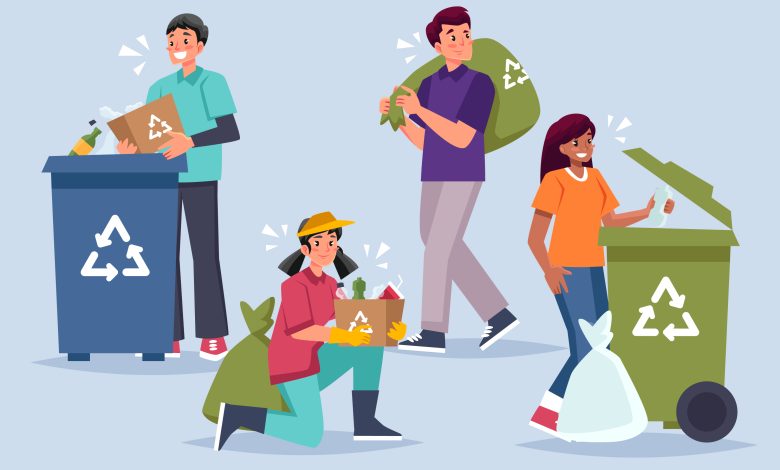Proper Solid waste management can help you save mon

Malaysia disposes of estimated 14 tonnes of garbage throughout 2022. A sizeable portion of that total comes from commercial and industrial firms. Steps are being taken to lessen the quantity of garbage produced and wasted because of the strain these wastes have on our environment and economy. The reason solid waste management in Malaysia is so crucial is that it will shield our household or businesses from the dangers associated with solid trash.
By encouraging the reuse and decrease approach and ultimately lowering landfill trash, the Malaysian government continues to advocate for a more efficient form of waste management. A sustainable solid waste management in Malaysia requires careful planning as well as effective resource allocation and management.
To curb commercial waste generated from manufacturing activities, The government offers targeted incentives to businesses who engage in environmental management activities, including recycling of garbage like hazardous and non-hazardous waste, chemicals, and recovered rubber. These businesses may be eligible for investment tax allowances of 60% on qualifying capital expenditures made within a 5-year window or income tax exemptions of 70% under Pioneer Status for a 5-year term.
Additionally, since 2014 Budget, the Government significantly increased the tax incentive for green technology in order to achieve more integrated solid waste management in Malaysia. By combining practises of solid waste management in Malaysia such as collection, storage, composting, and disposal with other essential recycling, recovery, or waste treatment activities, the incentive hopes to persuade businesses to reevaluate their strategy. These initiatives will improve businesses’ operations and develop Malaysia’s ecosystem for green technology, which will include a more comprehensive approach to waste management.
Why Waste Reduction Is Important for Business
A business can save money by reducing waste.
- Spend less on supplies
- Conserve energy and the environment.
- Lowering current trash disposal expenses and protecting against rising future disposal expenses
- satisfy consumer demand for “green” goods and ecologically responsible companies
- Avoid causing more environmental harm by creating and discarding extra materials.
- Give staff members the chance to collaborate on an environmental initiative to raise employee morale
- Minimise the possibility of future liability related to the disposal of solid wastes.
How to Compost, Reduce, Reuse, and recycle
Lowering waste generation
By minimising the amount of garbage your company generates, source reduction is the most effective strategy to reduce your disposal costs. If you buy and trash less, you have less to get rid of. You may probably eliminate a large amount of the garbage your company creates by doing a waste stream analysis.
Using leftover waste
A practical way to cut waste is to reuse things in their current state. Instead of purchasing new or recycled goods, it is typically less expensive to clean or repair existing items so they can be used again.
Recycling
Products that cannot be discarded or used again can often be recycled. When items are created using recycled materials rather than new ones, energy and natural resources are conserved, and environmental pollution is decreased. Recycling can significantly reduce disposal expenditures for your company.
Composting
The trash stream contains a sizable proportion of organic garbage, including food leftovers and lawn trimmings. These materials are typically the heaviest as well, therefore hefty garbage removal is more expensive. On-site composting as well as composting at public or commercial facilities are also options.
Easy Ways to Cut Waste
Here are some simple methods to cut back on the waste your company generates. The majority of these entail small adjustments to practises and routines at work.
Paper for Writing and Printing
- Invest on recyclable paper.
- Upkeep of mailing lists
- Manila envelopes can be reused.
- Scratch pads can be made from old paper.
- Instead of printing or purchasing individual paper copies for each employee, circulate or produce electronic versions of memos, documents, periodicals, and reports.
- When sending internal memos, utilise old letterhead.
- Before printing, proofread materials on the computer screen.
- Save documents electronically rather than printing them out.
- Use refurbished office supplies.
- For tangible copies, make use of centralised files.
- Improve inventory control to prevent products from going bad or becoming useless.
- Avoid buying disposable items.
- Online waste tracking.
- When exchanging internal notes and electronic documents, use email instead of paper.
Shipping and Packaging
- Order products with less packaging, in concentrated form, or in large quantities.
- Request from suppliers to avoid overpack orders.
- To ensure that the materials you order arrive in returnable containers, request this.
- Reuse cardboard boxes and foam packaging pellets (sometimes known as “peanuts”), or find someone who will.
- Create a mechanism for delivering foam pellets and cardboard boxes back to distributors for recycling.
- Wooden pallets should be returned, used, and repaired.
- With shipments to your branch offices, stores, and warehouses, swap out cardboard boxes for strong, reusable ones.
Equipment
- Use refurbished office supplies.
- Purchase waste-reducing machinery, such as:
-high-quality, long-lasting, and repairable copiers that can produce two-sided copies
-dishwashing appliances (so that you can use durable dinnerware).
- Use rechargeable battery technology.
- Printer and fax cartridges should be recycled or recharged.
- Install washable filters in the furnace and air conditioner.
Organic Wastes and Landscaping
- Pick a landscape plan that needs little upkeep and water.
- Use food leftovers, grass clippings, and leaves to create a beneficial soil amendment by composting them (or make sure your landscape contractor composts).
- Purchase compost to add to the topsoil (or request that your landscape contractor do so).
- Make high-quality potting soil from non-fatty food waste by using a worm bin (vermicompost).
Personal services and food
- Use cloth tablecloths, napkins, and towels in place of paper products.
- Encourage workers to bring reusable containers for their meals.
- Use sturdy dishes, flatware, cups, and glasses for serving meals and beverages to the general public instead of disposable items. Although a dishwasher is necessary, the cost savings will quickly cover its cost.
- The restrooms should include automated hand dryers.
- Encourage workers to consume food and beverages on sturdy cups and plates, and keep extra on available for guests.
- Provide surplus food (Emerson Good Samaritan Act).
By affecting your consumers’ behaviour, you and your company can also contribute to waste reduction. Here are some concepts.
- Inform your clients of the value of waste reduction. Promotional campaigns, newsletters and brochures (printed on recycled paper), banners, newspaper adverts, product displays, retail signage, and labels are examples of effective communications tools.
- Encourage customers to reuse their shopping bags by asking them if they have their own, praising them when they do, offering a reward for doing so, and launching a marketing campaign.
- Present waste-reducing options alongside waste-producing ones to clients. Bulk goods, reusable cloth goods like diapers, coffee filters, towels, and napkins, solar-powered devices like watches and calculators, rechargeable batteries, products packaged in recyclable and recycled materials, razors with replaceable blades, dependable picnic dinnerware, high-quality goods, and repairable goods are a few examples.
- Give your clients a rebate when they return shopping bags, bulk-item containers, or coffee and soda cups that need to be refilled.
What Makes a Waste Reduction and Recycling Program Successful?
Three primary steps are involved in creating an efficient waste reduction programme for your company: planning, establishing the groundwork, and implementing the programme as part of regular operations. Here are the duties that must be completed at each stage.
Organizing and Getting Ready
- Investigate the costs and waste stream.
- Create a waste reduction proposal and win your management team’s approval.
- Examine employee interest and solicit their cooperation.
Creating the Base
- Choose a coordinator for recycling and trash reduction.
- Set objectives.
- Establish procurement guidelines, recycling programmes, and waste reduction strategies.
- Find markets for trash or opt for a recycling company.
- Determine the origins of recycled goods.
- Create a mechanism for gathering and storing garbage.
How to Access the Program Online
- Inform your staff.
- Promote and put the programme into action.
- Create mechanisms for evaluation and monitoring.
Purchasing recycled goods
Recycling involves more than just gathering recyclables. Until these items are transformed into new products and bought, the cycle is not finished. You may support the development of a steady market for recycled goods by choosing products that are (1) made from recycled materials, (2) recyclable, and (3) packaged in recyclable materials. The next time your business acquires supplies, keep an eye out for the following products manufactured from recycled materials:
- Toilet paper, hand towels, and tissue
- vessels made of cardboard and paper board
- packaging supplies
- oil for lubrication and motors
- Carpeting, lumber, screens, and downspouts made of plastic
- constructing elements
- asphalt.
It also helps to buy secondhand or refurbished things rather than brand-new ones. Search for
- Refilled laser printer ink cartridges
- Support for retreaded tyres
- Office equipment that has been used and reconditioned
Last but not least, share this article to your friends who might interested if you found this article useful. Also, you can continue your reading journey at Dew Articles ! Ciao !




